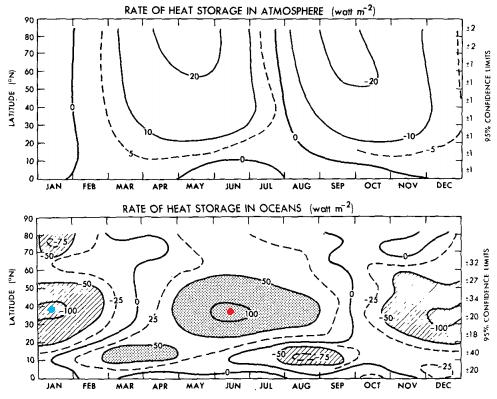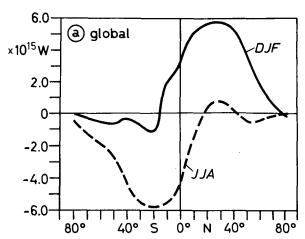Is Willis wrong at WUWT? or Sensitivity and Sensibility II
Posted on 8 July 2010 by MarkR
Willis Eschenbach at Wattsupwiththat believes that since temperatures in a hemisphere change ~5 oC from summer-winter for a change in sunlight equivalent to ~40 CO2 doublings, that CO2 causes almost no global warming because thunderstorms must cancel it out.
The last article showed some physics suggesting that this lacks some sensibility and we should look for heat being stored or moving around the planet. If lots of heat is being stored then Earth isn't near equilibrium and if lots of heat is moving around then by looking at sunlight alone you will underestimate climate sensitivity.
Heat storage
Oort and Vonder Haar found that a hemisphere stores heat in summer and releases it in winter. Figure 1 shows, slightly confusingly, this heat storage.
 Figure 1 - Atmosphere and ocean heat storage. The x-axis counts months and the y-axis latitudes. The lines are contours of constant heat flow. At around 40 degrees latitude we see ‘islands’ highlighted with dots showing that in January the oceans release about 100 W m-2 of heat, and in June they absorb about 100 W m-2.
Figure 1 - Atmosphere and ocean heat storage. The x-axis counts months and the y-axis latitudes. The lines are contours of constant heat flow. At around 40 degrees latitude we see ‘islands’ highlighted with dots showing that in January the oceans release about 100 W m-2 of heat, and in June they absorb about 100 W m-2.
They assert that in summer (JJA), the Northern Hemisphere stores about 85 W m-2 more than in winter (DJF) – and that the change in sunlight is just over 110 W m-2.
Heat transfer
Whilst Willis assumes that the only change in heat flow into a latitude is from the Sun, a chunk of energy is transported to and from other latitudes so the actual heating is smaller. Boning and Herrmann used Carissimo et al’s data on the oceans to show that in winter, there is a net heat flow of over 3 PW into the Northern Hemisphere, and in summer there is a net flow of over 4 PW out.

Figure 2 –Heat flow across different latitudes in northern winter (solid line) and summer (dashed line). Positive means that heat is going north and negative means it’s going south.
Added together, this is a change of ~15 W m-2 over the hemisphere. Trenberth & Caron later used satellites to find that the atmosphere accounts for most of the heat transport and came up with a slightly different estimate.
These figures are rough but we see that scientists have measured where most of the extra summertime heat is going and it’s not being reflected by Willis’ thunderstorms. Just how wrong is he?
Climate sensitivity from seasonal cycles
Knutti et al used the seasons to estimate climate sensitivity but they avoided some of these problems by using climate models with a range of different feedbacks and then seeing what they predicted for summer-winter changes. They found that the best match with reality was given by models that give 3-3.5 oC for a CO2 doubling.
Independent lines of evidence support a 2-4.5 oC range so it seems pretty likely that WUWT is at least 40 times out – sorry Willis, there’s some physics here, it’s not just a cruel joke.































 Arguments
Arguments






























On the contrary, most of the energy being stored from the increased greenhouse effect is going into the oceans:
Doubling greenhouse gases causes more infrared radiation to return back to the Earth's surface. This isn't just theory or climate modelling. The increased greenhouse effect has been directly observed by surface measurements and satellites.